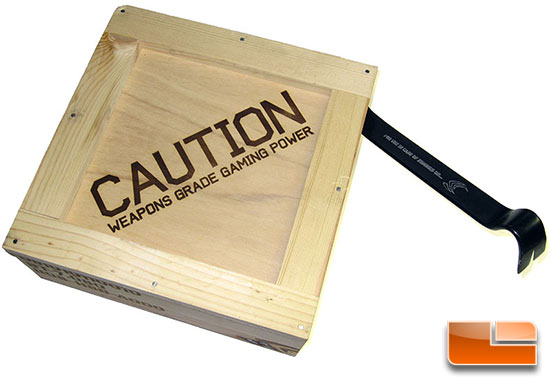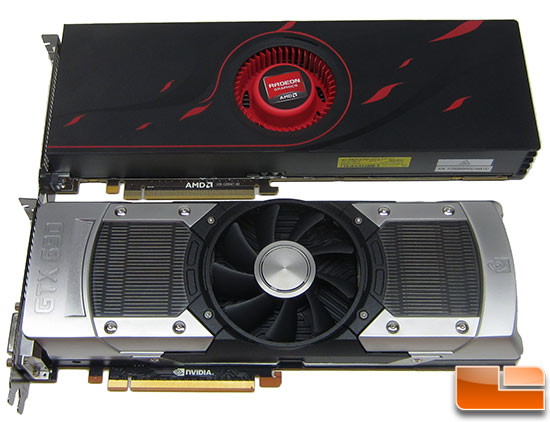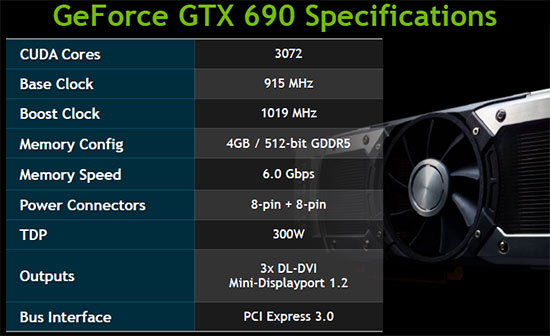NVIDIA GeForce GTX 690 4GB Video Card Review
NVIDIA Unleashes A Monster – GeForce GTX 690

We all knew that NVIDIA was working on a dual-GPU video card to replace the GeForce GTX 590 that was introduced last year, but no one knew when exactly it was coming. We, ourselves, only found out when this card was launching this past Saturday when NVIDIA CEO Jen-Hsun Huang told the world the news at the GeForce LAN in Shanghai, China. The company’s new video card, the GeForce GTX 690 was designed from the ground up to deliver the highest performance of any graphics card in history. NVIDIA didn’t stop there though as they paid special attention to the appearance of the card to ensure that this cards design would be over the top. When a pry bar and a wood crate showed up at our door, we knew this card was something special.

And this video card will be a game game changer, as it is powered by two Kepler GK104 GPUs that have a combined 3072 CUDA cores, 7.08 Billion transistors and 4GB of GDDR5 memory! NVIDIA wanted gamers to be able to crank up the gaming realism with NVIDIA Surround, NVIDIA 3D Vision Surround and PhysX, so NVIDIA needed a card that would that could deliver and for that the GeForce GTX 690 comes to market. If you are a gamer that cranks up the image quality and run at an Ultra HD screen resolution (2560×1600) on a with a single graphics card be sure that you are paying attention!
You can also clearly see that card is a different breed as NVIDIA made a number of changes to the overall appearance of the card by using exotic solutions like the following:
- An exterior frame made from trivalent chromium-plated aluminum, providing excellent strength and durability
- A fan housing made from a thixomolded magnesium alloy, which offers excellent heat dissipation and vibration dampening
- High-efficiency power delivery with less resistance, lower power and less heat generated using a 10-phase, heavy-duty power supply with a 10-layer, two-ounce copper printed circuit board
- Efficient cooling using dual vapor chambers, a nickel-plated finstack and center-mounted axial fan with optimized fin pitch and air entry angles
- Low-profile components and ducted baseplate channels for unobstructed airflow, minimizing turbulence and improving acoustic quality

It sounds like NVIDIA has started to put more emphasis on style and design, which is great! For years most video card have been noting more than black plastic boxes that go inside your PC. Most video cards feel cheap and flimsy, so when we picked up the NVIDIA GeForce GTX 690 and felt the metal construction and the overall weight of the card we were pleasantly surprises and happy with what NVIDIA has done.

The GeForce GTX 690 is a dual-GPU card that uses two GK104 cores, which just happens to be the core used on the GeForce GTX 680 single-GPU video card. Since it uses two of these cores, the features of the card are for the most part doubled. That means the GeForce GTX 690 ships with 16 Streaming Multiprocessor (SMX) units that are good for a total of 3072 CUDA cores (1536 per GPU).
NVIDIA lowered the base clock on each GPU though, so the GeForce GTX 690 has a baseclock of 915MHz versus 1006MHz on the GeForce GTX 680. This means that the GeForce GTX 690 will likely perform a little slower since it has had a reduction in the core clock speed. The boost clock on the GTX 690 goes up to 1019MHz by default though, which is not too far off from the 1058MHz seen on the GTX 680. The typical Boost clock is based on the average video card running a wide variety of games and applications. The actual Boost clock will vary depending on actual system conditions since this new series of cards has dynamic clocks. With a boost clock that is just 3.9% slower than the GeForce GTX 680 we can assume that the GeForce GTX 690 will perform slightly slower than two GeForce GTX 680 video cards running in SLI.
The memory subsystem of the GeForce GTX 690 consists of four 64-bit
memory controllers (256-bit) with 2GB of GDDR5 memory per GPU (4GB
total). The base clock speed of the GeForce GTX 680 is 1006MHz and the
typical Boost clock speed is 1058MHz. NVIDIA left the memory speed
unchanged, so both the GeForce GTX 680 and the new GeForce GTX 690 have
the memory running at an impressive 6008MHz (effective).

NVIDIA informed us that the GeForce GTX 690 board typically draws around 263W of power, but the board has been fitted with two 8-pin power connectors. Combined with the PCI Express interface, this means that the GeForce GTX 690 can draw up to 375W of power if needed. The GeForce GTX 690 is rated at 300W TDP, so this leaves a considerable amount of headroom for overclocking.
Let’s take a closer look at the GeForce GTX 690!

Comments are closed.